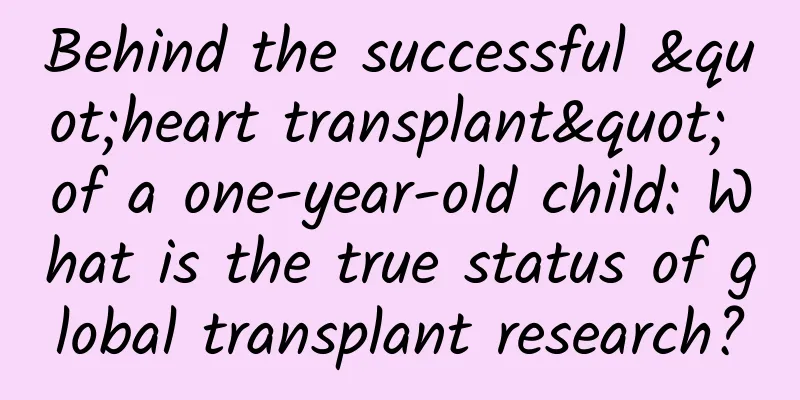Behind the successful "heart transplant" of a one-year-old child: What is the true status of global transplant research?

|
Heart transplantation has always been considered a difficult medical procedure and one of the essences of global transplantation research. Recently, exciting news came from Shanghai: Xiaoxiao (pseudonym), who is 1 year and 9 months old, weighs only 15 kilograms and suffers from a rare dilated cardiomyopathy, successfully underwent a heart transplant operation at the Children's Hospital Affiliated to Fudan University in Shanghai, becoming the youngest and lightest heart transplant patient in East China. Photo: Doctors and nurses examine Xiaoxiao (Source: Children's Hospital Affiliated to Fudan University) Behind this medical miracle, not only does it represent the brilliant achievements of global transplantation research, but it is also one of the important achievements made by China in transplantation research. Looking around the world, the United States has always been an important contributor to transplantation research, but in recent years, Asia, especially China, has become an important force in global transplantation research. Xiaoxiao's treatment journey is the result of the joint efforts of the Chinese medical team and the unremitting exploration of global transplantation research. So, what is the current status of transplantation research around the world? What are the future development trends? Recently, based on the latest data from the AMiner database, the AMiner data team released a new report, "2023 AMiner Transplantation Journal Insight Report" , which reveals the research history, new outlook and important development trends of transplantation disciplines from multiple dimensions, including the basic situation of SCIE transplantation journals in Q1, basic situation of journals, comprehensive analysis of global transplantation research, competition between China, Japan and the United States, and research focus of the discipline. Now, let us take a deeper look at the report and explore the vigorous development of transplantation around the world. Comprehensive analysis of global transplantation research : 20 years of research, revealing the changes in the international landscape of transplantation 1. The number of transplantation papers has increased 2.2 times in the past 20 years From the changes in the number of journal articles in the past 20 years, the development of transplantation is like a surging wave. Back to 2003, 6 journals published 3,418 papers on transplantation. However, as time goes by, the research volume gradually rises in fluctuations. From a macro perspective, the overall publication volume trend in the past 20 years can be roughly divided into three stages: 2003-2010, a period of fluctuating rise, 2011-2019, a period of significant growth and entering a stable period (of which, 2012 increased by 57.2% month-on-month), and 2020-2023 (a period of fluctuation and decline due to global events) is a period of challenge and decline. Data show that 2022 decreased by 24% compared with 2018. In 2023, due to incomplete inclusion of journal supplements and other reasons, the decline was relatively high. Overall, taking 2022 as the time node, the number of articles published in 2022 still reached 2.2 times that of 2003, indicating that the number of articles published in the six transplantation journals is on the rise. Although it has experienced fluctuations, from initial fluctuations to steady growth, research in the field of transplantation has gradually matured. Data source: AMiner open platform (unit: article) 2. Evolution of publication trends in the top 10 countries in global transplant research over the past 20 years Countries of origin of first-author scholars who published papers in six journals worldwide. Among the top 10 countries with the most papers published in the past 20 years, countries in Asia, Europe, and North America are all shortlisted: 1) The rise of Asia : Strong growth in China and South Korea The publication data of 6 journals show that Asia has performed strongly in the past 20 years. The number of publications by Japanese first-author scholars will almost remain in the top six before 2022. The rankings of China and South Korea have gradually climbed. China has risen rapidly from a relatively low position, surpassing 9 countries to become the world's second largest publisher for the first time in 2013, and ranked second from 2016 to 2020, showing strong research vitality. South Korea's publication trend is similar to that of China, and it also achieved significant growth from 2011 to 2019, with the highest number of publications ranking third in the world, contributing to the rise of the Asian region. 2) European stability contribution: continued stability in the UK, Germany and France The overall publication volume in Europe is relatively stable. The publication volume rankings of six journals in the United Kingdom, Germany, and France have remained stable in the top 5, top 7, and top 8 respectively in the past 20 years. Although the total number of publications is far behind that of the United States, the publication volume is relatively stable. 3) North America continues to lead: The United States occupies a dominant position and leads by far in terms of the number of publications North America has been a major contributor to global transplantation research, and the United States has been ahead of other countries in the past 20 years, with the highest number of publications being 2,345 papers published in 6 journals in 2020, nearly five times the number of publications published by China, which ranked second in the same period. Although the number of publications fluctuated between 2020 and 2023 due to global events, the overall research publication volume still occupies a dominant position. Overall, the multi-center nature of global transplantation research has made the field more dynamic and diverse, and the contributions of scholars from various countries have formed a complex and rich international academic network. In the future, we should continue to pay attention to the rapid growth of research in Asia, the stable contribution of Europe, and the leading position of North America to promote the coordinated development of global transplantation research. Data source: AMiner open platform (unit: bit) Data source: AMiner open platform (unit: article) 3. The flourishing of transplantation research in the world in the past 20 years 1) Early Exploration: 1998-2002 Academic enthusiasm is emerging: Between 1998 and 2002, a total of 9,711 papers were published in 443 regions around the world. The northern hemisphere countries, including Europe, North America and Asia, dominated, highlighting the leading position of the northern hemisphere in this field. The research area is wide, but Asia is relatively weak, among which Japan published 614 papers, accounting for 6% of the total during the period, while only 8 regions in China published papers, accounting for 1% of the total. Focus on high-yield regions: From 1998 to 2002, some cities became hot spots for transplantation research, such as England, Ile-de-France in France, Bavaria in Germany, Pennsylvania in the United States, etc. These regions may have strong research strength and resources in early transplantation. 2) Mid-term expansion: 2008-2012 Research volume surges: Compared with 1998-2002, the number of regions and total volume of transplantation research worldwide increased significantly from 2008 to 2012, up 28% and 178% respectively, with a total of 26,999 papers published in 569 regions. This shows that global attention to transplantation is gradually heating up, and countries are actively participating and contributing. The United States, Germany, France, the United Kingdom and other countries are still dominant, but the contributions of other countries are also gradually increasing, highlighting the internationalization trend of this field. Focus on high-yield areas: From 2008 to 2012, some cities remained hot spots for transplantation research, such as Pennsylvania, Massachusetts, California in the United States, Brandenburg in Germany, and Ile-de-France in France. Rise of Asia and Europe: Compared with previous data, the status of Asia and Europe in transplantation research has improved from 2008 to 2012, reflecting the growth and progress of these two regions in medical research. The number of papers published in China increased to 28 cities, with a total of 1,130 papers. 3) Latest trends: 2018-2022 Continuous growth, diversified and dispersed trends: From 2018 to 2022, the total number of transplantation research papers and the number of regions continued to rise. A total of 32,663 papers were published in 690 regions, an increase of 247 regions compared with the initial period, and the number of papers published increased by 236% year-on-year. Although the core regions with high paper publication volume (such as the United States, the United Kingdom, etc.) continue to maintain their leading position in high paper publication, the increase in the number of global paper publication regions reflects the diversification and dispersion trend of transplantation research. The rise of China: Compared with the past, the contribution of Asia (especially China) in transplantation research has gradually become more prominent. 31 regions in China published a total of 2,037 papers, which is 14 times the total number of early studies. In particular, some cities in China, such as Beijing, Shanghai and Guangdong, have seen a significant increase in the number of papers published, marking a booming rise in this field. Overall, these data show that global research activities in transplantation have become more prosperous in the past 20 years, moving from centralized research to diversified and international research, providing a solid foundation for future medical progress. Data source: AMiner open platform (unit: article) The Contest and Competition between China, Japan and the United States in the Past 20 Years 1. Competition among China, Japan, and the United States: Transplantation discipline changes over the past 20 years The trend chart of the number of first-author research scholars and the number of institutions in China, Japan, and the United States over the past 20 years reveals the huge disparity between China and the United States and the obvious changes in the pattern between China and Japan. The number of first-author research scholars and institutions in the United States has always been in the leading position, and the overall trend is rising. Under the influence of global events, it still stands out in 2023. However, China and Japan have been competing for nearly 20 years, and China has gradually surpassed Japan to become the main country in Asia for transplantation of six journals. Among the first authors of the six journals, the number of Chinese first authors has increased sharply from only 58 in 2003 to 526 in 2019, showing a strong growth trend. Japan was relatively ahead before 2012, but gradually declined thereafter. In 2019, the gap with China widened to 206 places, and the gap between institutions was 9, showing a large gap. Overall, the United States still maintains its leading position in transplant research, but China's strong rise in the number of scholars and institutions indicates that competition between China and the United States in the transplant field will become more intense in the future, while Japan faces relative challenges and changes. Data source: AMiner open platform (unit: article) Data source: AMiner open platform (unit: article) 2. Competition among top transplantation institutions and leading scholars in China, Japan, and the United States Judging from the number of institutions that published papers in the six journals, Sun Yat-sen University ranked first in the field of transplantation in China with 653 papers published, becoming the leading institution in the field of transplantation in China. Zhejiang University, the University of Hong Kong, Chang Gung University, Sichuan University and other universities have also made remarkable achievements in this field, publishing more than 200 papers. At the same time, data shows that first-author scholars such as Weiqiang Ju and Jian Zhou from Sun Yat-sen University play an important role in the field of transplantation in China, and their research contributions cannot be ignored. In Japan, Kyoto University ranked first with 486 publications, and Osaka University, the University of Tokyo, and Hokkaido University also made outstanding research contributions in this field. At the same time, first-author scholars such as Yasuhiko Sugawara from the University of Tokyo and Toru Ikegami from Kyushu University have made significant contributions to Japanese transplantation. Among the relevant institutions in the United States, Harvard University has published more papers than the first institutions in China and Japan, topping the list with 1,807 papers, becoming the leader in transplantation research in the United States. Eight well-known institutions, including the University of Pittsburgh, Mayo Clinic, and the University of Minnesota, have also made significant contributions to transplantation research that surpass other countries, with more than 1,000 papers published. At the same time, data shows that first-author scholars such as James D. Perkins from the University of Washington and Goldberg David S from the University of Pennsylvania have extensive research influence in the field of transplantation in the United States. At the same time, from the relationship between the number of papers published by first-author scholars and research institutions in China, Japan, and the United States, although Kyoto University and Harvard University have the highest number of papers published in the field of transplantation, the research results of the top 1 institutions in Japan and the United States are relatively widely distributed, rather than concentrated in individual scholars. In contrast, China's Sun Yat-sen University has a significant position in the field of transplantation. Not only does it perform well in terms of the number of papers published by the institution, but it also has 5 scholars listed in the list of top first-author scholars. This shows that the university has a relatively concentrated number of scholars in the field of transplantation research. The data show that the researchers and institutions in the field of transplantation in China, Japan and the United States maintain international competitiveness, providing a solid foundation and inexhaustible impetus for the development of this field. This ecological system of cooperation and competition will further promote the innovation and application of transplantation research. Data source: AMiner open platform (unit: article) Data source: AMiner open platform (unit: pieces/articles) Data source: AMiner open platform (unit: pieces/articles) Data source: AMiner open platform (unit: pieces/articles) In general, global transplantation research has shown a vigorous development trend in the past 20 years. Transplantation research has gradually become internationalized and diversified, providing a solid foundation for future medical progress. With the deepening of research in various countries, the focus of transplantation has shifted to clinical practice and research, hoping to bring more advanced and effective medical services to patients around the world in the future, and jointly promote the prosperity and progress of global transplantation. The above content is a summary of the latest report released by the AMiner data team - "2023 AMiner Transplantation Journal Insight Report". The above is a partial summary of the report. Please go to the official website for detailed reports and journal details. The report includes the basic situation of relevant journals, the basic situation of journals, a comprehensive analysis of global transplantation research, the competition between China, Japan and the United States, and the focus of disciplinary research and the birth and fall of research focus. |
<<: World's oldest wild bird: At least 72 years old and still able to fall in love
>>: How did life originate? High-energy particles from the sun may be the key
Recommend
With a lead efficiency rate of up to 75%, how can K12 educational institutions break through in marketing!
In 2019, Qiwen Education, a local K12 education a...
Is it enough to just take effervescent tablets? You need to supplement these 10 things to enhance your immunity
Contributed by "Cat Doctor Comics"...
How does weather affect air quality? A guide for residents to protect themselves from air pollution in autumn and winter →
As the autumn breeze brings coolness and winter a...
Solid info! Tips for writing information flow copy!
I worry about writing creative ideas every day Ho...
5 copywriting skills, do you master them if you are in operation?
There are two characteristics of excellent operat...
Guike Zhihu live streaming camp, 0 basics to help you earn 20,000 a month
Guike Zhihu Sales Practice Camp will help you ear...
World Tsunami Awareness Day | How can we predict the arrival of a tsunami that creates huge waves?
November 5th is World Tsunami Awareness Day. Toda...
At least 1 billion people in the country have this problem with their teeth! Why is periodontitis so common?
Ge Shaohua | Dean of Shandong University School o...
Tips and strategies for placing Weibo Fans Advertising!
The eyewear industry has reached a historical jun...
The earliest urban planning in modern China turned out to be a little-known
Author: Liu Su, Professor of School of Architectu...
Analyzing the way of training large models from the perspective of Chinese culture: Taking DeepSeek as an example
With the rapid development of artificial intellig...
Is soy sauce full of “technology and hard work”? Is “zero additives” really better?
Recently, the food safety field has been in turmo...
Ma Huateng said: Tencent QQ group file storage capacity has been upgraded from 2G to 10G
On February 14, Tencent QQ issued an announcement...
Community operation from 0 to 1500+, the 5 key words I summarized
Some people say that a community is a net woven b...
998 yuan nibiru H1 review
Nibiru H1 is fashionable and cost-effective, and ...









